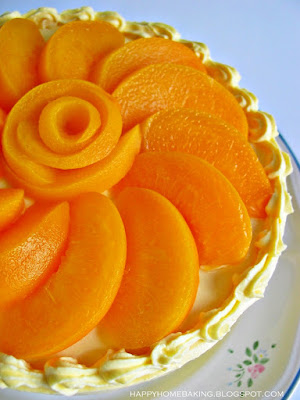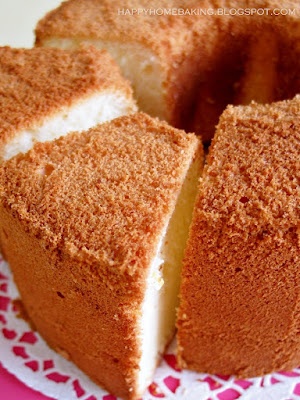 Time has zoomed passed so fast that unknowingly, another year has gone by. It seems like my son has grown up at such a tremendous speed that I have no choice but to accept that he is a big kid now. Looks like I have only a few more years to have him all for myself before he spreads his wings and embraces his own world.
Time has zoomed passed so fast that unknowingly, another year has gone by. It seems like my son has grown up at such a tremendous speed that I have no choice but to accept that he is a big kid now. Looks like I have only a few more years to have him all for myself before he spreads his wings and embraces his own world.To celebrate his birthday, I baked him a special cake which is a combination of both his all-time favourites...oreo cookies and durian! Even though my younger boy protested...he won't eat any durians, I still went ahead to make it as the rest of us are all durian lovers ;)
 As I was expecting a crowd, I made an 8" cake by adapting my favourite 7" sponge cake recipe. I was glad that the sponge cake turned out well as I was really just trying my luck to meddle with the ingredient amount! I whipped up some non-dairy cream and added in some durian pulp. It tasted yummy! Then I sliced the sponge cake into three layers and sandwiched each layer with some non-dairy whipped cream followed by a layer of fresh durian pulp. The cake was then covered with the left over durian whipped cream mixture before it was covered generously with lots of oreo cookie crumbs.
As I was expecting a crowd, I made an 8" cake by adapting my favourite 7" sponge cake recipe. I was glad that the sponge cake turned out well as I was really just trying my luck to meddle with the ingredient amount! I whipped up some non-dairy cream and added in some durian pulp. It tasted yummy! Then I sliced the sponge cake into three layers and sandwiched each layer with some non-dairy whipped cream followed by a layer of fresh durian pulp. The cake was then covered with the left over durian whipped cream mixture before it was covered generously with lots of oreo cookie crumbs. Except for a couple of kids who are non-durian lovers, all the guests enjoyed the cake. The durain was really good...it was very creamy and came with very thick flesh and had got a bitter sweet taste. An excellent choice to please both 'camps' of durian lovers...those who prefer sweet durians vs those who just love a stronger bitter taste. It's a pity I didn't have the chance to take a photo of a slice of cake. Even though I love the cake, I doubt I would make it again any sooner as I really couldn't stand the stinky fridge after having this durian cake sitting in it all night!
Except for a couple of kids who are non-durian lovers, all the guests enjoyed the cake. The durain was really good...it was very creamy and came with very thick flesh and had got a bitter sweet taste. An excellent choice to please both 'camps' of durian lovers...those who prefer sweet durians vs those who just love a stronger bitter taste. It's a pity I didn't have the chance to take a photo of a slice of cake. Even though I love the cake, I doubt I would make it again any sooner as I really couldn't stand the stinky fridge after having this durian cake sitting in it all night!I will post the recipe unless there are many requests for it since not everyone likes durian ;)
(As there are a number of requests, I have posted the recipe here.)
Ingredients:
(makes one 20cm cake)
Ingredients A:
130g cake flour
4 eggs, room temperature
120g caster sugar
30g unsalted butter, melted
40ml fresh milk
1 teaspoon vanilla extract
Ingredients B:
50g durian flesh (pureed)
300ml non-dairy whipping cream
Ingredients C:
150g durian flesh (pureed)
Ingredients D:
1 tablespoon sugar
60ml (4 tablespoons) hot water
Method:
To make the sponge cake:
- Sift cake flour, set aside. Line the sides and bottom of a 20cm (8 inches) round pan with parchment paper, set aside. Pre-heat oven to 170degC. Position rack at the lower bottom of the oven.
- With an electric mixer, whisk eggs and sugar on HIGH speed for about 5 to 7 mins, until the batter double in volume and is ribbon-like (the beater should leave a ribbon-like trail when the batter is lifted up). Turn to LOW speed and whisk for another 1 to 2 mins. Whisking at low speed helps to stabilise the air bubbles in the batter.
- Add sifted cake flour into the batter in 3 separate additions. Gently fold in the flour with a spatula each time the flour is added. Take care not to deflate the batter.
- Add the melted butter, fold with spatula until well blended
- Add in fresh milk, vanilla extract and fold in gently with spatula.
- Pour the batter into the pan and bake for 30~35 mins, or until a skewer inserted in the centre comes out clean. Unmold and invert onto cooling rack, remove parchment paper and let cool completely.
To make the filling: - Blend durian flesh (Ingredient B) until the pulp becomes smooth*. (As the durian flesh is quite thick, the blade of your blender may not work properly, stir the mixture with a spoon or add one or two teaspoons of water to get it going. *Depending on preference, blend the durian flesh to the desired consistency, I didn't blend it till very smooth, there were still tiny chunks of durian pulp/fibre.) Do the same for Ingredient C.
- With an electric mixer, whisk non-dairy whipping cream till stiff. Add the 50g of durian puree to the whipped cream. Fold in with a spatula, blend thoroughly. (Depending on the consistency of the durian puree, tiny bits of durian fibre would be visible in the whipped cream mixture.)
To assemble: - Dissolve the sugar in hot water (Ingredients D). Let cool.
- Slice the cake horizontally into 3 layers. Place one layer of the sponge cake on a 20cm cake board. Brush the surface of the sponge layer with the sugar syrup (this is to keep the sponge layers from drying out upon chilling).
- Spread about 1.5 cups of filling evenly on the sponge layer. Spread half of the durian puree (Ingredient C) evenly over the filling.
- Brush both sides of the second layer of sponge cake with the sugar syrup and place it over the first layer. Spread with 1.5 cups of filling followed by the remaining durian puree.
- Brush both sides of the last layer of sponge cake with the sugar syrup and spread the remaining filling on the surface and sides evenly. Leave the cake to chill in the fridge for at least 3~4 hours.
- Remove cake from fridge and cover the whole cake with crushed oreo cookie crumbs (remove the fillings between the cookies) and decorate as desired. Keep the cake in the fridge before serving.

















